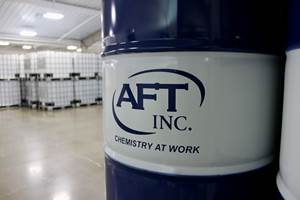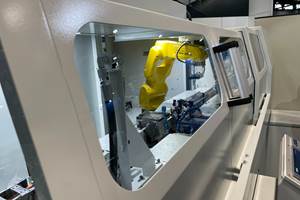Handling Chips In Hog Heaven
The Harley-Davidson Motor Company is concentrating on increasing productivity to meet the growing demand for its product line. Among the contant improvements to their manufacturing processes is an overhead system that transports chips and coolant from eight machining stations to a central separation and filter unit.
In the early 1980s, Harley-Davidson Motor Company (Milwaukee, Wisconsin) was on the brink of extinction. While trying to compete with economical imported motorcycles, the company's quality was lost. In 1981, a management team bought the company, and the rebound started. The company used just-in-time inventory, statistical process control quality, and employee involvement programs, along with improved manufacturing processes and the introduction of new models and restyled ones. Sales rose, and the company began expanding.
Today, Harley Davidson is concentrating on increasing productivity to meet the growing demand for its product line. Its solution is a corporatewide strategy called Plan 2003, implemented in 1996, designed to double manufacturing capacity by the year 2003 coinciding with Harley Davidson's 100 year anniversary.
According to Eric Rhodes, manufacturing engineer at Harley Davidson's Pilgrim Road Powertrain facility (Menomonee Falls, Wisconsin), the plan's objective is to increase the number of motorcycles produced while also improving quality and overall efficiency. Plan 2003 is being implemented expeditiously, with new manufacturing and assembly facilities being added and new capital equipment acquisitions to achieve the productivity goals, with quality governing all decisions.
Faced with lengthening delivery schedules and the introduction of new models by other manufacturers, Plan 2003 was developed to increase productivity, efficiency and to continuously improve quality. Steps taken so far include a new assembly plant in Kansas City, Missouri, and the Pilgrim Road Powertrain plant.
At the Pilgrim Road facility, production has begun on the new Twin Cam 88 'Fat' Head engine along with the long-time standard Evolution Vtwin series. One of Mr. Rhodes' responsibilities has been bringing on board the cylinder head machining line for these engines. It is a complex manufacturing cell consisting of six Okuma MC 500 horizontal machining centers, a Witzig & Frank Turmatic Triflex machining system from Germany, and a combination machining/assembly (press fit of valve seats and guides) system turnkeyed by Milwaukee Machine & Engineering, plus a WesTech conveyor line. Completing the system is Viavent, an advanced chip transporting and coolant processing system from Mayfran International (Cleveland, Ohio). It is an overhead system that transports chips and coolant from all eight machining stations to a central separation and filter unit.
"The Viavent system answered all of our requirements and concerns as set forth by the Plan 2003 guidelines," Mr. Rhodes reports. "It is installed above floor, so there's little chance of ground and environment contamination, plus there was no need to tear up existing floors for storage tanks and trenches to route piping. Being overhead, we can easily modify or add on to the system as future requirements may warrant. Because the system eliminates individual chip conveyors, hoppers and filters at each machine, the floor layout of the cylinder head line is more compact, making it easier for cell attendants to move from one machine to the next, loading and unloading parts. Additionally, the system is closedloop, so there's minimal coolant mist in the air."
The Viavent system's contribution to the quality of the cylinder heads is based on the fact that coolant is filtered to a 10 micrometer particle size or less using a main filter unit and a secondary cleaning tank that helps maintain better finishes on parts. The company anticipates that this will also result in longer life of tools and decreased wear on machine components, but the cell has not been in use long enough for studies to be complete yet. The filtered coolant was especially critical to the performance of the Turmatic Triflex, which operates with high pressure of 550 to 600 psi.
"Also considered in our selection of the Viavent system is the fact that a single chip hopper, instead of eight, is more easily monitored and removed when full, plus the simple operation of the coolant transporting system itself," Mr. Rhodes says.
At each of the machines within the cell at Harley Davidson, there is a compact pump station housed in a small holding tank. The pump station and all pipes at this point are set on floor level, and HarleyDavidson installed a wire screen platform around the cell not only to cover the pipes and pumps, but also to provide an ergonomic height for cell attendants to load and unload machines. Chips, strings, fines and the coolant are directed from the machines' beds to these stations where they are then pumped up a vertical rise discharge pipe of 2 inches in diameter and flow into a horizontal pipe run of initially 5 inches in diameter. The horizontal run is routed up in the roof trusses and proceeds, with other connections from the various machines, until it descends to the central chip separation unit and dual filters. As additional discharge pipes join the run, the pipe's diameter is increased to 6 inches and finally to an 8-inch diameter size.
At predetermined time intervals, the Viavent PLC controller signals a foot or discharge valve located just prior to the separation/filter unit to close, in effect allowing the system's pipes to fill with coolant. Sensors monitor the level of coolant, and once the correct height is reached, a second signal is sent to open both the discharge valve and valves located in the control vessels (mechanisms called EHB units by Mayfran, mounted at the highest points in the system). A combination of fluid level and air pressure flushes coolant, chips and sediment through the pipes and to the filter unit. When the cylinder head line is in full production, the system will handle an estimated 3,000 lbs of machining chips per day.
One problem was discovered during the flush cycle when the system is allowing coolant levels to rise. The pump stations at the Okuma machining centers overflowed—back pressure and too much coolant use created this condition. This problem was quickly resolved by moving a check valve in the discharge pipe farther away from the machine.
Related Content
168 Manufacturing's Coolant System Automates Delivery
PMTS 2023: FullShop systems monitor and replenish all CNC machine sumps with optimized top-off ratios before the coolant runs low.
Read MoreAFT's Semi-Synthetic Coolant Extends Sump Life
Advanced Cool 2200 provides high visibility while machining, keeping the machine and parts clean with no odor issues.
Read MoreIMTS 2022 Review: Attention to Automation Extends Beyond the Robot and the Machine
The advance toward increasingly automated machining can be seen in the ways tooling, workholding, gaging and integration all support unattended production. This is the area of innovation I found most compelling at the recent International Manufacturing Technology Show.
Read MoreSTLE Opens Registration for 2024 Annual Meeting
The Society of Tribologists and Lubrication Engineers’ 2024 STLE Annual Meeting & Exhibition will take place May 19-23 at the Minneapolis Convention Center in Minneapolis, Minnesota.
Read MoreRead Next
The Cut Scene: The Finer Details of Large-Format Machining
Small details and features can have an outsized impact on large parts, such as Barbco’s collapsible utility drill head.
Read More3 Mistakes That Cause CNC Programs to Fail
Despite enhancements to manufacturing technology, there are still issues today that can cause programs to fail. These failures can cause lost time, scrapped parts, damaged machines and even injured operators.
Read More

























